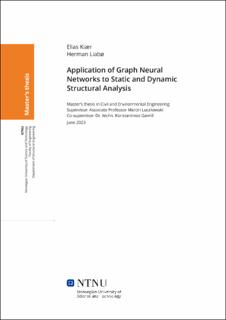| dc.contributor.advisor | Luczkowski, Marcin | |
| dc.contributor.advisor | Gavriil, Konstantinos | |
| dc.contributor.author | Kiær, Elias | |
| dc.contributor.author | Liabø, Herman | |
| dc.date.accessioned | 2023-11-05T18:19:35Z | |
| dc.date.available | 2023-11-05T18:19:35Z | |
| dc.date.issued | 2023 | |
| dc.identifier | no.ntnu:inspera:146720801:34392954 | |
| dc.identifier.uri | https://hdl.handle.net/11250/3100626 | |
| dc.description.abstract | Denne avhandlingen begynner med et fokus på utvikling og implementering av et rammeverk for statisk og
dynamisk Finite Element Analysis (FEA) som plugins til Rhino Grasshopper sitt parametriske miljø. Dette
er gjort ved utnyttelse av Euler-Bernoulli bjelketeori og dynamisk analyse ved numerisk integrasjon. Den
siste delen av arbeidet gjort i denne avhandlingen begir seg ut på potensialet for å bruke maskinlæringsverktøy, spesifikt Graph Neural Networks (GNNs), for tradisjonelle oppgaver innen konstruksjonsteknikk.
Motivert av den ofte arbeidsintensive og ressurskrevende naturen ved å lage en FEA modell, har denne
avhandlingen som mål å utforske mer effektive tilnærminger for situasjoner i konstruksjonsmessig analyse
der beregningseffektivitet foretrekkes fremfor absolutt presisjon. I slike situasjoner kan godt designede
Neural Network (NN)-modeller, gitt nok trening, fungere som potente løsninger for å håndtere disse utfordringene.
Arbeidet i denne avhandlingen gir en detaljert fremstilling av utviklingen av Velociraptor, et omfattende
rammeverk for konstruksjonsanalyse som integrerer både FEA verktøy og Artificial Intelligence (AI) -
teknologier. Dette omfatter utvikling og implementering av et FEA-rammeverk for 2D- og 3D-konstruksjoner,
referert til som Velociraptor2D (V2D) og Velociraptor3D (V3D), og to Neural Network (NN) modeller -
ArchNN og TrussNN - som er implementert ved bruk av GNNs. Spesifikt er ArchNN designet for å forutsi
nodemomenter i buer, mens TrussNN er designet for å forutsi nodale tidshistorier for fagverksbroer.
V2D og V3D viser solid ytelse når sammenlignet med Robot Structural Analysis og Karamba3D. På samme
måte er den prediktive nøyaktigheten til ArchNN og TrussNN anerkjennelsesverdig sammenlignbar med
resultatene fra V2D og V3D i mange tilfeller. ArchNN og TrussNN demonstrerer potensialet for å bruke
GNNs for oppgaver innen konstruksjonsteknikk.
Samarbeidet mellom FEA Grasshopper-komponentene og NN-modellene som er utviklet åpner muligheten
for et omfattende konstruksjonsanalyserammeverk, som inkluderer FEA og AI, i det parametriske miljøet.
I dette oppsettet gir NN-komponenter raskere beregninger, mens FEA-komponenter leverer referanseresultaterfor verifisering og pålitelighet. Her trener og tester FEA NN-modellene, og øker dermed deres anvendelighet over tid til et mer variert spekter av strukturer. | |
| dc.description.abstract | This thesis begins with a focus on the development and implementation of a framework for both static
and dynamic Finite Element Analysis (FEA) as plugins to the Rhino Grasshopper parametric environment,
leveraging Euler-Bernoulli beam theory and the Newmark average acceleration method. The main part of
the work done in this thesis embarks on the potential of using machine learning tools, specifically Graph
Neural Networks (GNNs), for traditional structural engineering tasks.
Motivated by the often labour-intensive and resource-demanding nature of creating a Finite Element Analysis
(FEA) model, this thesis aims to explore more efficient approaches for situations in structural behaviour
analysis where computational efficiency is preferred over absolute precision. In such scenarios,
well-designed neural network models, given enough training, can serve as potent solutions to address these
challenges.
Showcased in this work is the process of developing the structural analysis framework Velociraptor, including
both FEA tools and Artificial Intelligence (AI) tools. It encompasses the development and implementation
of an FEA framework for 2D and 3D structures, referred to as Velociraptor2D (V2D) and
Velociraptor3D (V3D), and two Neural Network (NN) models - ArchNN and TrussNN - which are implemented
utilizing GNNs. Specifically, ArchNN is designed to predict nodal moments in arches, whereas
TrussNN is designed to predict nodal time histories for truss bridges.
The V2D and V3D exhibit robust performance when benchmarked against Robot Structural Analysis and
Karamba3D. Similarly, the predictive accuracy of ArchNN and TrussNN commendably matches the output
from V2D and V3D in many cases. ArchNN and TrussNN demonstrate the potential of using GNNs for
structural engineering analysis tasks.
The collaboration between the FEA Grasshopper plugins and the NN models opens the potential for a
comprehensive structural analysis framework, incorporating FEA and AI, in the parametric environment.
In this setup, NN plugins provide faster computations, whereas FEA plugins furnish benchmark results
for verification and reliability. Herein, the FEA trains and tests the NN models, thereby enhancing the AI
applicability over time to a more diverse range of structures. | |
| dc.language | eng | |
| dc.publisher | NTNU | |
| dc.title | Application of Graph Neural
Networks to Static and Dynamic
Structural Analysis | |
| dc.type | Master thesis | |
